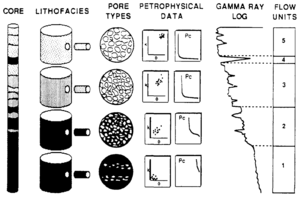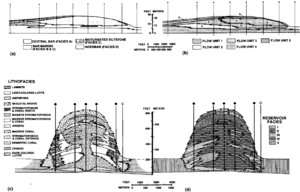Flow units for reservoir characterization
Petroleum geologists and hydrologists have long recognized the need to define quasi-geological/petrophysical units to formalize their descriptions of rock strata as storage containers and conduits for flow of fluids. Maxey[1] even proposed the introduction of the term hydrostratigraphic unit into the Code of Stratigraphic Nomenclature to fulfill this need. Other terms that have been introduced include reservoir facies,[2] reservoir unit,[3] flow unit,[4][5] and lithohydraulic unit.[6]
This article outlines one approach to zonation of a reservoir for modeling and prediction of performance—the flow unit concept. The subdivision of a reservoir into flow units provides a practical means for reservoir zonation that makes use of both geological and petrophysical data representing heterogeneity observed at several scales (see Geological heterogeneities).
Definition and characteristics of flow units[edit]
A flow unit is defined as a mappable portion of the total reservoir within which geological and petrophysical properties that affect the flow of fluids are consistent and predictably different from the properties of other reservoir rock volumes (modified from [5]). Flow units have the following characteristics in common:
1. A flow unit is a specific volume of a reservoir, which is composed of one or more reservoir quality lithologies and any nonreservoir quality rock types within that same volume, as well as the fluids they contain.
Flow units are internally consistent, but not necessarily homogeneous, in terms of either geological or petrophysical properties. They may contain more than one reservoir quality lithology and they may include nonreservoir features such as shales and cemented layers. Petrophysical properties may correspond to those of lithofacies defined geologically. However, petrophysical similarities among lithofacies may indicate that those lithofacies should be grouped into a single flow unit if they are contiguous. Alternatively, petrophysical dissimilarities within a geologically defined lithofacies may dictate that subdivision of a single lithofacies into several flow units is warranted. A flow unit zonation differs in principle from a lithofacies zonation in that it integrates geological, petrophysical, and production data with the end purpose of describing fluid flow pathways in the reservoir, not the distribution of depositionally distinctive lithologies.
2. A flow unit is correlative and mappable at the interwell scale.
Because flow units are deterministic elements in a reservoir description, they must be of a scale that is correlative and mappable relative to well spacing. Flow units should be continuous at interwell scales, but they need not extend across the entire reservoir. Because some parts of a reservoir can be efficiently drained only on closer well spacings, the definition of some flow units may change with infill drilling and changes in production mechanism (such as initiation of waterflooding) during field life.
3. A flow unit zonation is recognizable on wireline logs.
Mappability in the subsurface requires that flow units be recognizable on wireline logs. Flow units recognizable only in core are useful only if all wells have been cored. Some method must be found to translate a flow unit zonation based on core to a zonation based on the wireline log suite available in a particular reservoir.
4. A flow unit may be in communication with other flow units.
Flow units may be in communication with one another across their boundaries, both in terms of pressure and in the ability of fluids to move vertically and laterally, or they may be completely isolated from one another by permeability barriers.
The fundamental requirement of flow unit delineation is that reservoir volumes in which properties that affect fluid flow differ are consistently distinguished. Furthermore, the extent of these volumes should be definable in the subsurface relying predominantly on wireline logs at existing well spacings.
Methods of defining flow units[edit]

There is no universally applicable set of rules by which to define flow units. Dividing a reservoir into flow units requires an integration of stratigraphic, sedimentological, structural, petrographic, petrophysical, and field performance data. The process is summarized as follows (Figure 1):
- Identify the major lithofacies, vertical sequences, and depositional environments from available core. Relate lithofacies, at the whole-core scale, to their mineralogical, textural, and pore level properties and to permeability, porosity, fluid saturations, and capillarity as measured on core plugs. Establish consistent relationships between rock properties and petrophysical properties.
- Determine what lithofacies, or associations of lithofacies, are probable flow units based on petrophysical properties, changes in texture, cementation, fracture density, differences in sedimentary structures or bedding styles, and/or separations by prominent shales or other features that may bear on fluid distribution and flow.
- Calibrate wireline log response to major rock types in as much detail as possible and with appropriate depth shifting of core to logs, in order to detect changes quantitatively in flow unit quality and to correlate major flow units to uncored wells. If cores are not available, cuttings, sidewall cores, patterns of textural change inferred from log signatures, cementation or shales detected on logs, downhole images of the borehole wall, microscanner logs, or other such information must be used in place of core (see Wireline methods).
- Establish the three-dimensional distribution of flow units by correlation of calibrated wireline logs. Knowledge of environments of deposition of the reservoir sequence is important to interpreting the style of correlation to be used and the expected patterns of external and internal geometry of any flow unit (see Lithofacies and environmental analysis of clastic depositional systems). During correlation, the flow unit zonation established in individual cored wells may change somewhat. Tying correlation horizons around a loop is critical because individual correlation sections alone can be deceptive.
- Test the validity of flow units established by consideration of production logs (see Production engineering methods), flow tests of small intervals, oil and water geochemistry (see Laboratory methods), repeat formation tester (RFT) surveys (see Wireline methods), injectivity logs, tracer surveys, and any available data on patterns of production through time. Modify the flow unit definitions as needed to accommodate the physical measurements of flow, if a rationale can be found for the differences.
The distribution of petrophysical properties such as porosity and permeability can be mapped within flow units using well control only or by applying geostatistical procedures to create stochastic realizations of these distributions “conditioned” on the well data (see Geological methods). Geostatistical techniques that have a strong stochastic component are consistent with, and complementary to, the flow unit concept, which is itself mostly deterministic.
Examples of application of flow units[edit]
Examples of field studies that apply the flow unit concept are listed in Table 1. A larger number of studies have identified and mapped lithofacies control on geometry and petrophysical properties of reservoirs but have not applied a flow unit classification to these subdivisions. Some examples are listed in Table 2 and illustrated in Figure 2. These studies are good examples of the stratigraphic and sedimentological component of the process of flow unit subdivision.
| Field | Application | References |
|---|---|---|
| Siliciclastic Reservoirs | ||
| Elk City, Oklahoma | Mapping of “flow unit-like” subdivisions of clastic rocks on the basis of lithological, well test, and production data | [7] |
| Hartzog Draw, Wyoming | Flow units applied to reservoir characterization of shelf sandstones for an EOF) project | [8] |
| Pembina, Alberta | Reservoir characterization of shelf sandstones by “lithohydraulic units” | [6] |
| Balmoral, North Sea | Flow unit model of turbidite sands integrating geological and petrophysical properties for reservoir simulation and management | [9] |
| Carbonate Reservoirs | ||
| Fields along the Cabin Creek anticline, Willisten basin | Combined lithological and petrophysical parameters of Ordovician-Silurian carbonates to recognize different reservoir types | [10] |
| Rainbow Lake, Alberta | Described “reservoir facies” within reef complexes | [11] |
| Jordan, Texas | Defined “flow units” of San Andres dolomites based on a number of geological and petrophysical characteristics | [12] |
| Field/Area/Formation | Application | References |
|---|---|---|
| Gulf Coast | Continuity and internal facies and petrophysical properties of sandstones | [13] |
| Frio Formation, Texas | Facies architecture of strand plain reservoirs | [14] |
| El Dorado field, Kansas | Effects of facies on productivity of deltaic sandstone | [15] |
| Hartzog Draw field, Wyoming | Effects of facies on productivity of shelf sandstone | [15] |
| Spraberry Trend, Midland basin, Texas | Facies architecture and petrophysical properties of submarine fan reservoirs | [16][17] |

See also[edit]
- Introduction to geological methods
- Subsurface maps
- Effective pay determination
- Geological cross sections
- Geological heterogeneities
References[edit]
- ↑ Maxey, G. B., 1964, Hydrostratigraphic units: Journal of Hydrology, v. 2, p. 124–129., 10., 1016/0022-1694(64)90023-X
- ↑ 2.0 2.1 Langston, J. R., and G. E. Chin, 1968, Rainbow Member facies and related reservoir properties, Rainbow Lake, Alberta: AAPG Bulletin, v. 52, n. 10, p. 1925-1955.
- ↑ Pettijohn, F. J., Potter, P. E., Siever, R. 1973, Sand and Sandstone: New York, Springer-Verlag, 618 p.
- ↑ 4.0 4.1 Hearn, C. L., Ebanks, W. J. Jr., Tye, R. S., Ranganathan, V. 1984, Geological factors influencing reservoir performance of the Hartzog Draw field: Journal of Petroleum Technology, v. 36, Aug., p. 1335–1344., 10., 2118/12016-PA
- ↑ 5.0 5.1 Ebanks, W. J., Jr., 1987, Flow unit concept—integrated approach to reservoir description for engineering projects, abst.: AAPG Bulletin, v. 71, n. 5, p. 551–552.
- ↑ 6.0 6.1 Krause, F. F., Collins, H. N., Nelson, D. A., Mochemer, S. D., French, P. R., 1987, Multiscale anatomy of a reservoir— geological characterization of Pembina-Cardium pool, west-central Alberta, Canada: AAPG Bulletin, v. 71, p. 1233–2260.
- ↑ Sneider, R. M., Richardson, F. H., Paynter, D. D., Eddy, R. R., Wyant, I. A., 1977, Predicting reservoir rock geometry and continuity in Pennsylvanian reservoirs, Elk City field, Oklahoma: Journal of Petroleum Technology, July, p. 851–866.
- ↑ Hearn, C. L., W. J. Ebanks Jr., R. S. Tye, and V. Ranganathan, 1984, Geological factors influencing reservoir performance of the Hartzog Draw field: Journalof Petroleum Technology, v. 36, Aug., p. 1335-1344.
- ↑ Slatt, R. M., Hopkins, G. L., 1990, Scaling of geological reservoir description to engineering needs: Journal of Petroleum Technology, Feb., p. 202–210.
- ↑ Roehl, P. O., 1967, Stony Mountain (Ordovician) and Interlake (Silurian) facies analogs of recent low-energy marine and subaerial carbonates, Bahamas: AAPG Bulletin, v. 51, n. 10, p. 1979–2032.
- ↑ Langsten, J. R., Chin, G. E., 1968, Rainbow Member facies and related reservoir properties, Rainbow Lake, Alberta: AAPG Bulletin, v. 52, n. 10, p. 1925–1955.
- ↑ Major, R. P., Holtz, M. H., 1989, Effects of geologic heterogeneity on waterflood efficiency at Jordan field, University Lands, Ector and Crane counties, Texas: 64th Annual Technology Conference of the Society of Petroleum Engineers, San Antonio, TX, Oct., SPE 19874, p. 633–640.
- ↑ Morton, R. A., Ewing, T. E., Tyler, N. 1983, Continuity and internal properties of Gulf Coast sandstones and their implications for geopressured fluid production: The University of Texas Bureau of Economic Geology Report of Investigations, n. 123, 70 pp.
- ↑ Tyler, N., Ambrose, W. A., 1985, Facies architecture and production characteristics of strandplain reservoirs in the Frio Formation, Texas: The Univ. of Texas Bureau of Economic Geology Report of Investigations, n. 146, 42 p.
- ↑ 15.0 15.1 Tillman, R. W., Jordan, D. W., 1987, Sedimentology and subsurface geology of deltaic forces, Admire GSO Sandstone, El Dorado field, Kansas, in Tillman, R. W., Weber, K. J., eds., Reservoir Sedimentology: SEPM Special Publication 40, p. 221–292.
- ↑ Guevara, E. H., 1988, Geological characterization of Permian submarine fan reservoirs of the Driver Waterflood Unit, Spraberry Trend, Midland Basin, Texas: The Univ. of Texas Bureau of Economic Geology Report of Investigations, n. 172, 44 pp.
- ↑ Tyler, N., Gholston, J. C., 1988, Heterogeneous deep-sea fan reservoirs, Shakelford and Preston waterflood units, Spraberry Trend, West Texas: The Univ. of Texas Bureau of Economic Geology Report of Investigations, n. 171, 38 p.